2009 DODGE DAKOTA child restraint
[x] Cancel search: child restraintPage 12 of 449
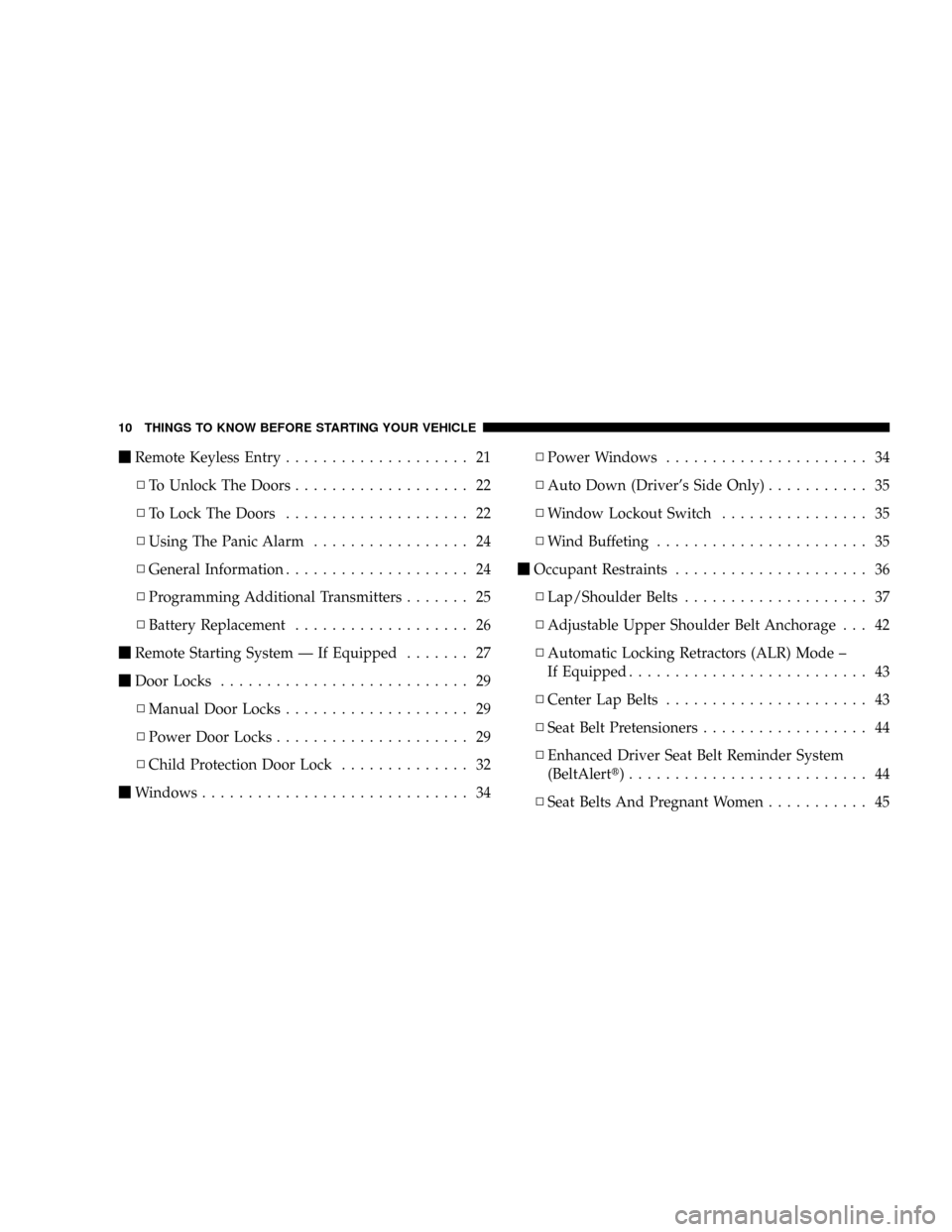
mRemote Keyless Entry.................... 21
NTo Unlock The Doors................... 22
NTo Lock The Doors.................... 22
NUsing The Panic Alarm................. 24
NGeneral Information.................... 24
NProgramming Additional Transmitters....... 25
NBattery Replacement................... 26
mRemote Starting System Ð If Equipped....... 27
mDoor Locks........................... 29
NManual Door Locks.................... 29
NPower Door Locks..................... 29
NChild Protection Door Lock.............. 32
mWindows............................. 34NPower Windows...................... 34
NAuto Down (Driver's Side Only)........... 35
NWindow Lockout Switch................ 35
NWind Buffeting....................... 35
mOccupant Restraints..................... 36
NLap/Shoulder Belts.................... 37
NAdjustable Upper Shoulder Belt Anchorage . . . 42
NAutomatic Locking Retractors (ALR) Mode ±
If Equipped.......................... 43
NCenter Lap Belts...................... 43
NSeat Belt Pretensioners.................. 44
NEnhanced Driver Seat Belt Reminder System
(BeltAlertt).......................... 44
NSeat Belts And Pregnant Women........... 45
10 THINGS TO KNOW BEFORE STARTING YOUR VEHICLE
Page 13 of 449
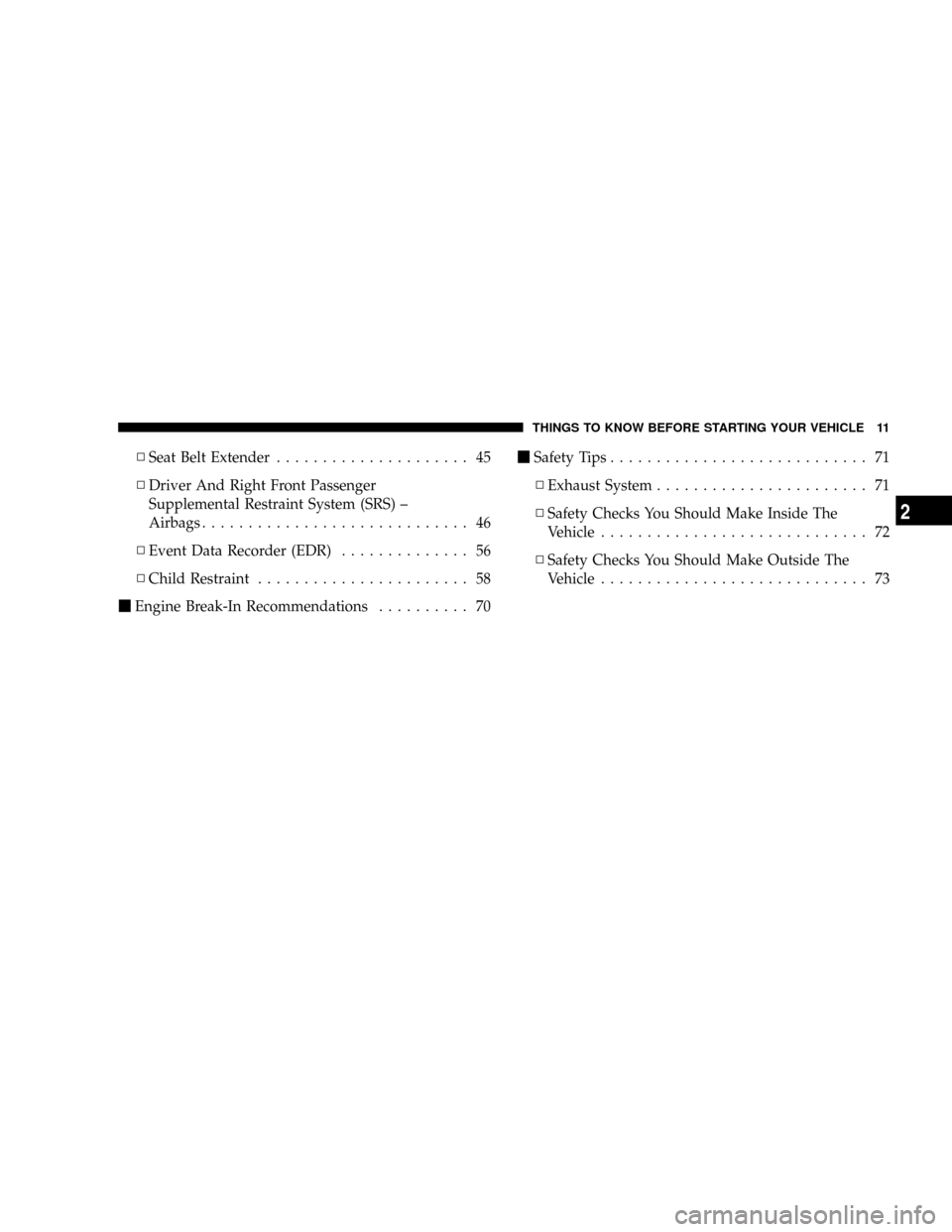
NSeat Belt Extender..................... 45
NDriver And Right Front Passenger
Supplemental Restraint System (SRS) ±
Airbags............................. 46
NEvent Data Recorder (EDR).............. 56
NChild Restraint....................... 58
mEngine Break-In Recommendations.......... 70mSafety Tips............................ 71
NExhaust System....................... 71
NSafety Checks You Should Make Inside The
Vehicle............................. 72
NSafety Checks You Should Make Outside The
Vehicle............................. 73
THINGS TO KNOW BEFORE STARTING YOUR VEHICLE 11
2
Page 38 of 449
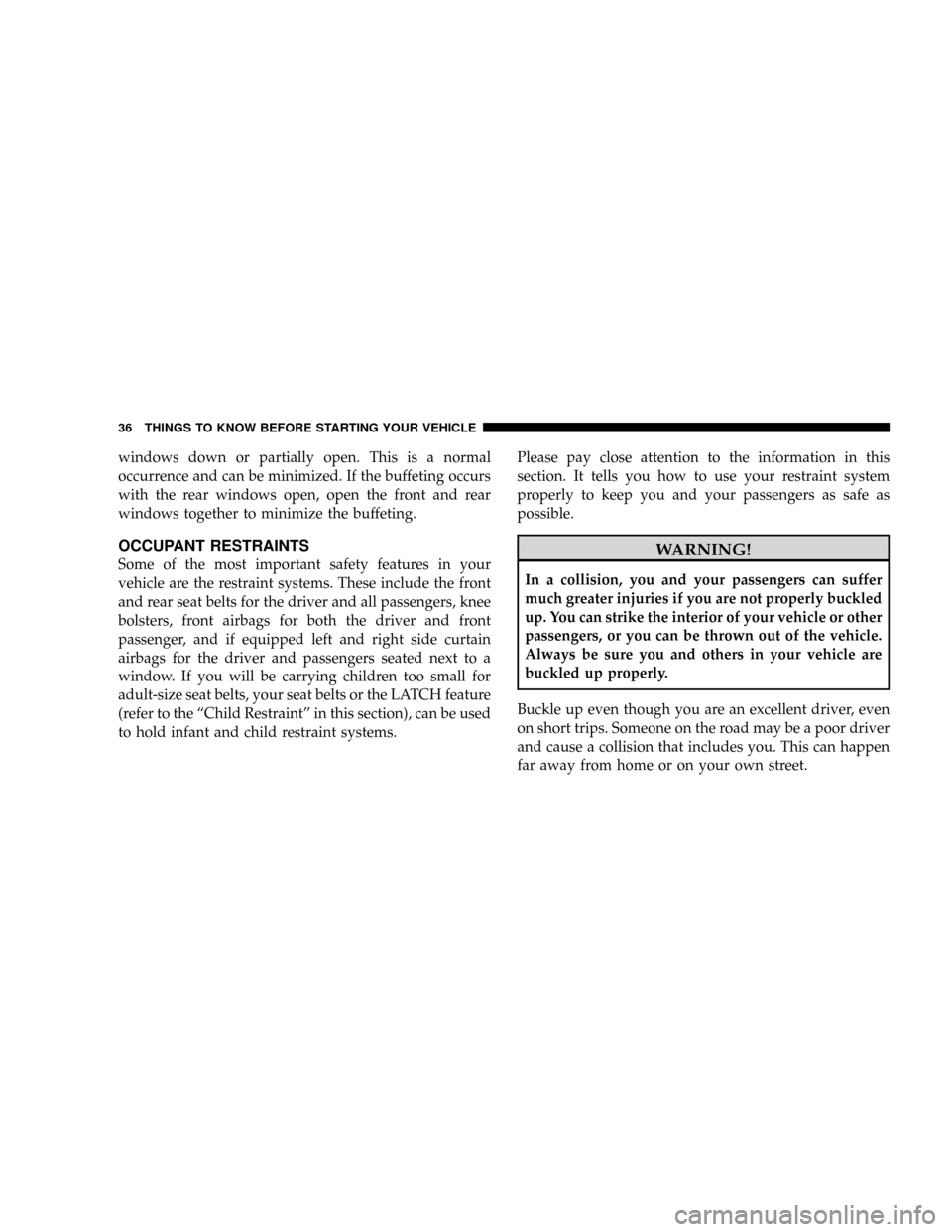
windows down or partially open. This is a normal
occurrence and can be minimized. If the buffeting occurs
with the rear windows open, open the front and rear
windows together to minimize the buffeting.
OCCUPANT RESTRAINTS
Some of the most important safety features in your
vehicle are the restraint systems. These include the front
and rear seat belts for the driver and all passengers, knee
bolsters, front airbags for both the driver and front
passenger, and if equipped left and right side curtain
airbags for the driver and passengers seated next to a
window. If you will be carrying children too small for
adult-size seat belts, your seat belts or the LATCH feature
(refer to the ªChild Restraintº in this section), can be used
to hold infant and child restraint systems.Please pay close attention to the information in this
section. It tells you how to use your restraint system
properly to keep you and your passengers as safe as
possible.WARNING!
In a collision, you and your passengers can suffer
much greater injuries if you are not properly buckled
up. You can strike the interior of your vehicle or other
passengers, or you can be thrown out of the vehicle.
Always be sure you and others in your vehicle are
buckled up properly.
Buckle up even though you are an excellent driver, even
on short trips. Someone on the road may be a poor driver
and cause a collision that includes you. This can happen
far away from home or on your own street.
36 THINGS TO KNOW BEFORE STARTING YOUR VEHICLE
Page 46 of 449
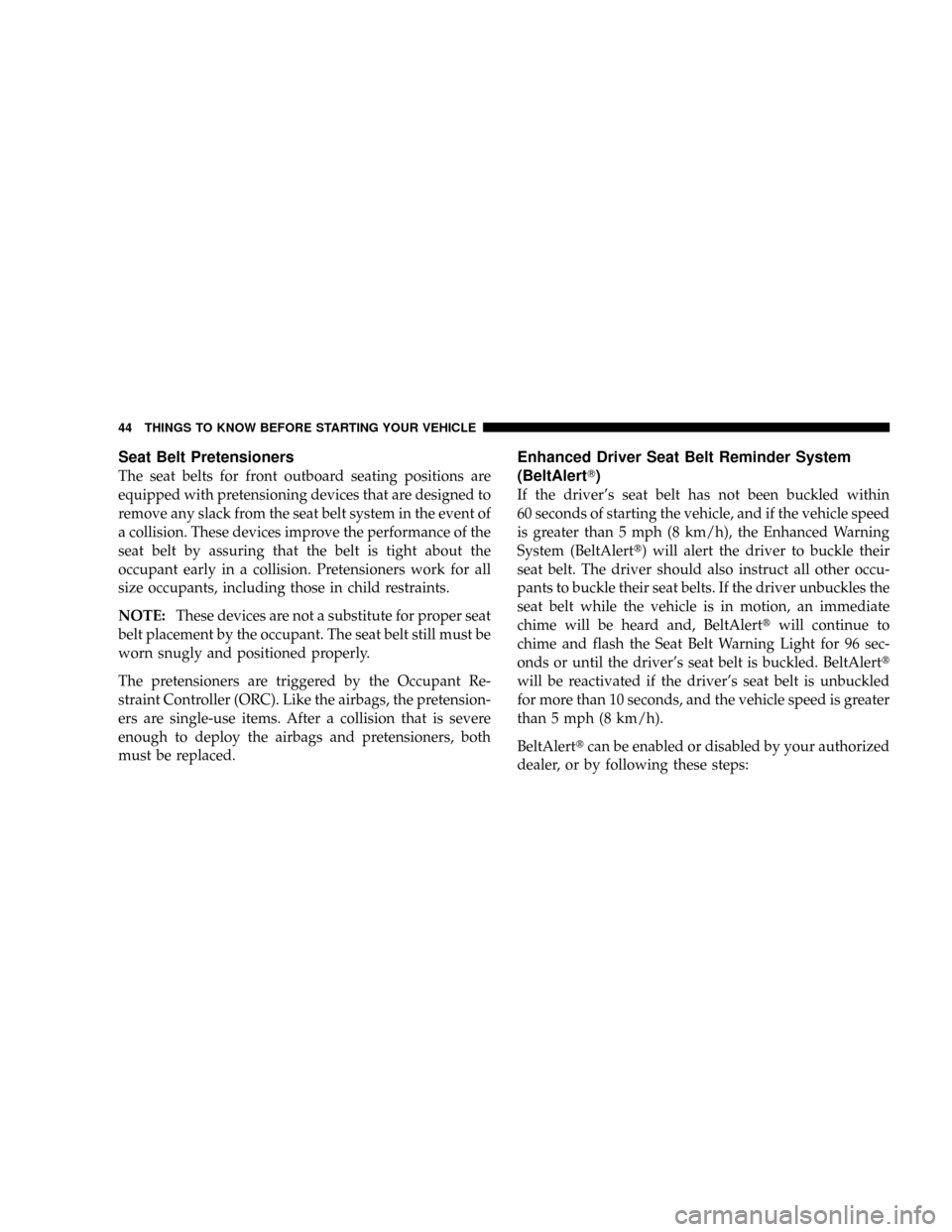
Seat Belt Pretensioners
The seat belts for front outboard seating positions are
equipped with pretensioning devices that are designed to
remove any slack from the seat belt system in the event of
a collision. These devices improve the performance of the
seat belt by assuring that the belt is tight about the
occupant early in a collision. Pretensioners work for all
size occupants, including those in child restraints.
NOTE:These devices are not a substitute for proper seat
belt placement by the occupant. The seat belt still must be
worn snugly and positioned properly.
The pretensioners are triggered by the Occupant Re-
straint Controller (ORC). Like the airbags, the pretension-
ers are single-use items. After a collision that is severe
enough to deploy the airbags and pretensioners, both
must be replaced.
Enhanced Driver Seat Belt Reminder System
(BeltAlertT)
If the driver's seat belt has not been buckled within
60 seconds of starting the vehicle, and if the vehicle speed
is greater than 5 mph (8 km/h), the Enhanced Warning
System (BeltAlertt) will alert the driver to buckle their
seat belt. The driver should also instruct all other occu-
pants to buckle their seat belts. If the driver unbuckles the
seat belt while the vehicle is in motion, an immediate
chime will be heard and, BeltAlerttwill continue to
chime and flash the Seat Belt Warning Light for 96 sec-
onds or until the driver's seat belt is buckled. BeltAlertt
will be reactivated if the driver's seat belt is unbuckled
for more than 10 seconds, and the vehicle speed is greater
than 5 mph (8 km/h).
BeltAlerttcan be enabled or disabled by your authorized
dealer, or by following these steps:
44 THINGS TO KNOW BEFORE STARTING YOUR VEHICLE
Page 50 of 449
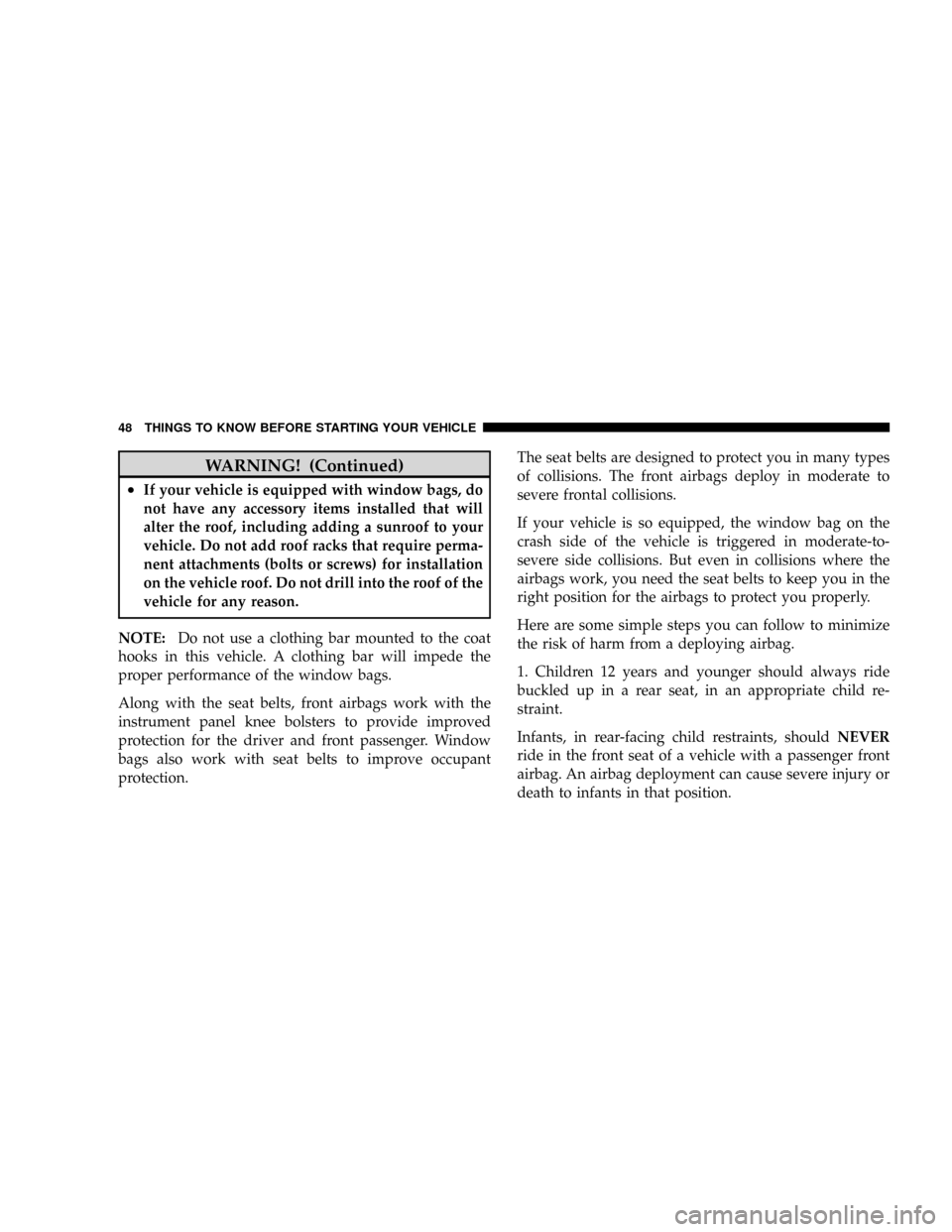
WARNING! (Continued)
²If your vehicle is equipped with window bags, do
not have any accessory items installed that will
alter the roof, including adding a sunroof to your
vehicle. Do not add roof racks that require perma-
nent attachments (bolts or screws) for installation
on the vehicle roof. Do not drill into the roof of the
vehicle for any reason.
NOTE:Do not use a clothing bar mounted to the coat
hooks in this vehicle. A clothing bar will impede the
proper performance of the window bags.
Along with the seat belts, front airbags work with the
instrument panel knee bolsters to provide improved
protection for the driver and front passenger. Window
bags also work with seat belts to improve occupant
protection.The seat belts are designed to protect you in many types
of collisions. The front airbags deploy in moderate to
severe frontal collisions.
If your vehicle is so equipped, the window bag on the
crash side of the vehicle is triggered in moderate-to-
severe side collisions. But even in collisions where the
airbags work, you need the seat belts to keep you in the
right position for the airbags to protect you properly.
Here are some simple steps you can follow to minimize
the risk of harm from a deploying airbag.
1. Children 12 years and younger should always ride
buckled up in a rear seat, in an appropriate child re-
straint.
Infants, in rear-facing child restraints, shouldNEVER
ride in the front seat of a vehicle with a passenger front
airbag. An airbag deployment can cause severe injury or
death to infants in that position.
48 THINGS TO KNOW BEFORE STARTING YOUR VEHICLE
Page 51 of 449
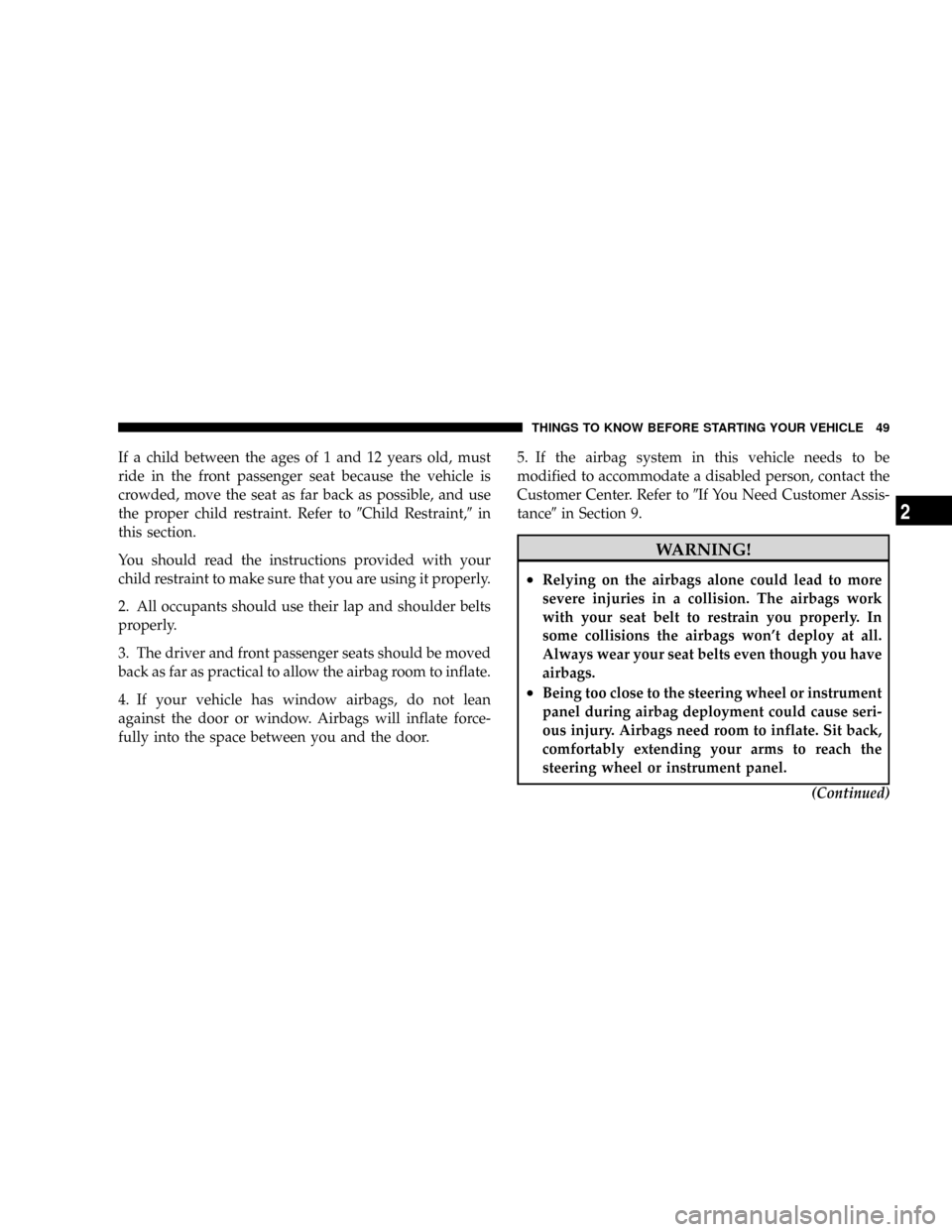
If a child between the ages of 1 and 12 years old, must
ride in the front passenger seat because the vehicle is
crowded, move the seat as far back as possible, and use
the proper child restraint. Refer to9Child Restraint,9in
this section.
You should read the instructions provided with your
child restraint to make sure that you are using it properly.
2. All occupants should use their lap and shoulder belts
properly.
3. The driver and front passenger seats should be moved
back as far as practical to allow the airbag room to inflate.
4. If your vehicle has window airbags, do not lean
against the door or window. Airbags will inflate force-
fully into the space between you and the door.5. If the airbag system in this vehicle needs to be
modified to accommodate a disabled person, contact the
Customer Center. Refer to9If You Need Customer Assis-
tance9in Section 9.
WARNING!
²Relying on the airbags alone could lead to more
severe injuries in a collision. The airbags work
with your seat belt to restrain you properly. In
some collisions the airbags won't deploy at all.
Always wear your seat belts even though you have
airbags.
²Being too close to the steering wheel or instrument
panel during airbag deployment could cause seri-
ous injury. Airbags need room to inflate. Sit back,
comfortably extending your arms to reach the
steering wheel or instrument panel.
(Continued)
THINGS TO KNOW BEFORE STARTING YOUR VEHICLE 49
2
Page 53 of 449
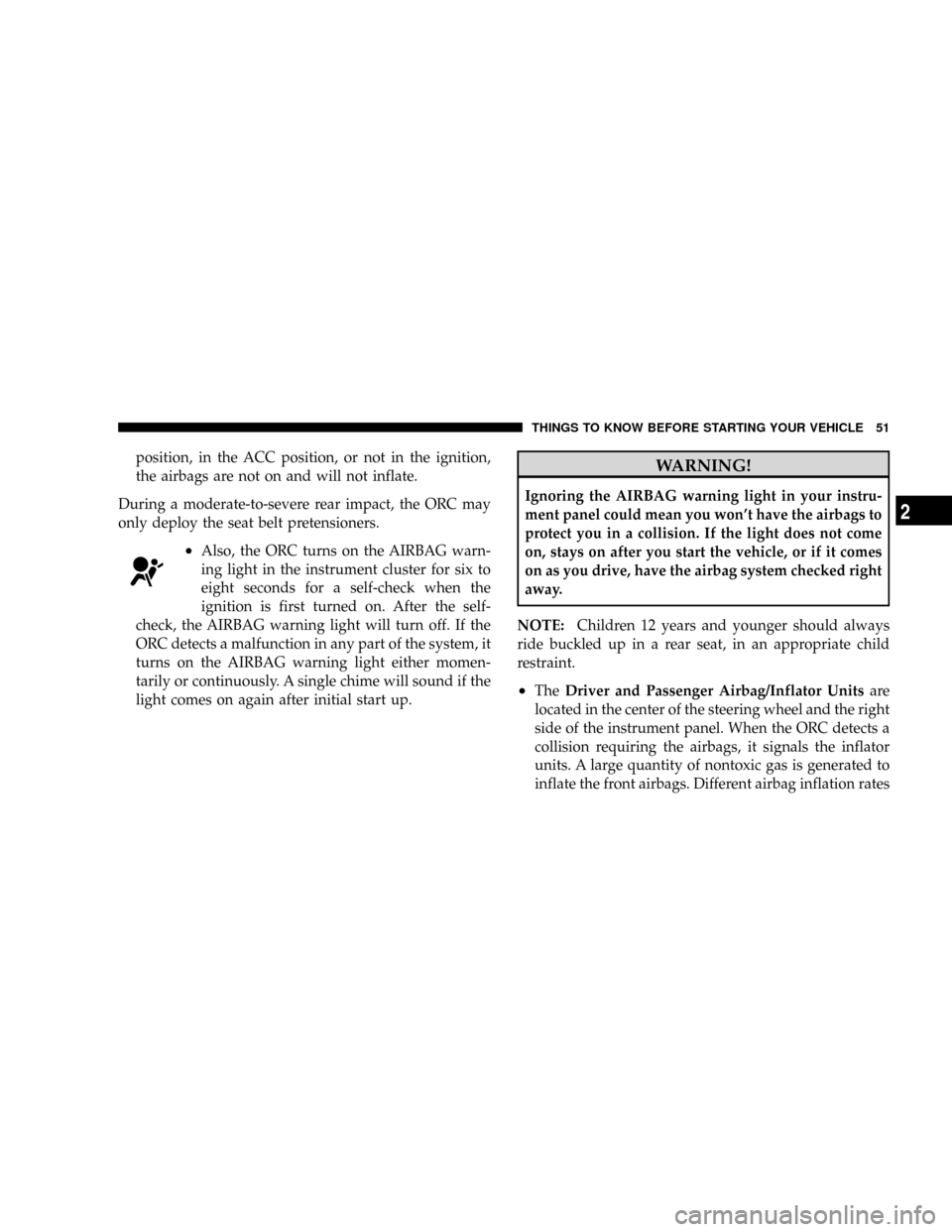
position, in the ACC position, or not in the ignition,
the airbags are not on and will not inflate.
During a moderate-to-severe rear impact, the ORC may
only deploy the seat belt pretensioners.
²Also, the ORC turns on the AIRBAG warn-
ing light in the instrument cluster for six to
eight seconds for a self-check when the
ignition is first turned on. After the self-
check, the AIRBAG warning light will turn off. If the
ORC detects a malfunction in any part of the system, it
turns on the AIRBAG warning light either momen-
tarily or continuously. A single chime will sound if the
light comes on again after initial start up.
WARNING!
Ignoring the AIRBAG warning light in your instru-
ment panel could mean you won't have the airbags to
protect you in a collision. If the light does not come
on, stays on after you start the vehicle, or if it comes
on as you drive, have the airbag system checked right
away.
NOTE:Children 12 years and younger should always
ride buckled up in a rear seat, in an appropriate child
restraint.
²TheDriver and Passenger Airbag/Inflator Unitsare
located in the center of the steering wheel and the right
side of the instrument panel. When the ORC detects a
collision requiring the airbags, it signals the inflator
units. A large quantity of nontoxic gas is generated to
inflate the front airbags. Different airbag inflation rates
THINGS TO KNOW BEFORE STARTING YOUR VEHICLE 51
2
Page 54 of 449
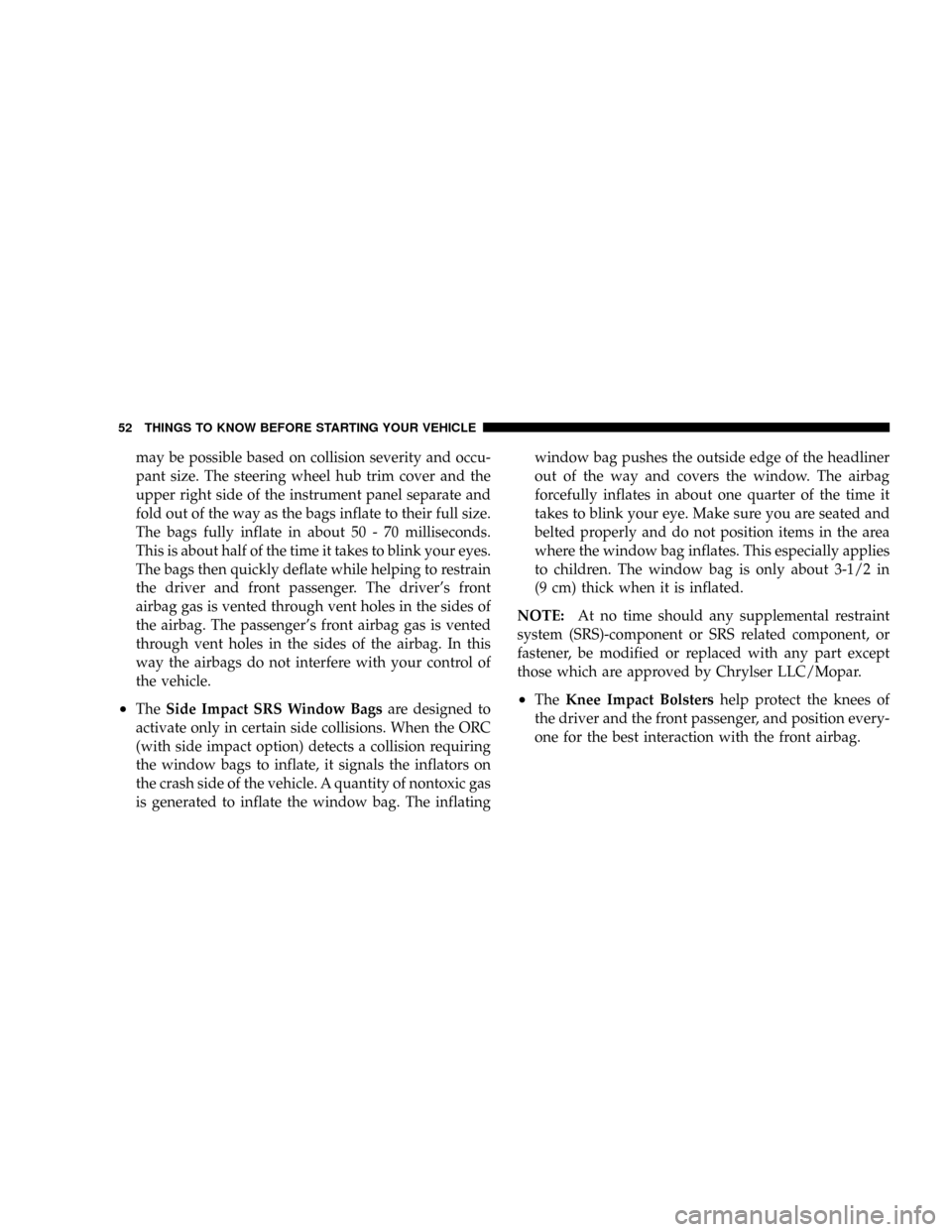
may be possible based on collision severity and occu-
pant size. The steering wheel hub trim cover and the
upper right side of the instrument panel separate and
fold out of the way as the bags inflate to their full size.
The bags fully inflate in about 50 - 70 milliseconds.
This is about half of the time it takes to blink your eyes.
The bags then quickly deflate while helping to restrain
the driver and front passenger. The driver's front
airbag gas is vented through vent holes in the sides of
the airbag. The passenger's front airbag gas is vented
through vent holes in the sides of the airbag. In this
way the airbags do not interfere with your control of
the vehicle.
²TheSide Impact SRS Window Bagsare designed to
activate only in certain side collisions. When the ORC
(with side impact option) detects a collision requiring
the window bags to inflate, it signals the inflators on
the crash side of the vehicle. A quantity of nontoxic gas
is generated to inflate the window bag. The inflatingwindow bag pushes the outside edge of the headliner
out of the way and covers the window. The airbag
forcefully inflates in about one quarter of the time it
takes to blink your eye. Make sure you are seated and
belted properly and do not position items in the area
where the window bag inflates. This especially applies
to children. The window bag is only about 3-1/2 in
(9 cm) thick when it is inflated.
NOTE:At no time should any supplemental restraint
system (SRS)-component or SRS related component, or
fastener, be modified or replaced with any part except
those which are approved by Chrylser LLC/Mopar.²TheKnee Impact Bolstershelp protect the knees of
the driver and the front passenger, and position every-
one for the best interaction with the front airbag.
52 THINGS TO KNOW BEFORE STARTING YOUR VEHICLE